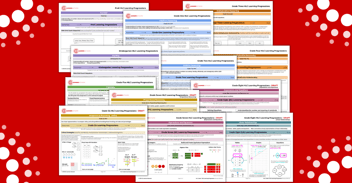
Using All Learners Online for Math Intervention Instruction
Published: October 18, 2024
Providing impactful math intervention is both a great privilege and a great challenge. When I speak with math specialists, there is often a common lament. There is regularly the sentiment that we’ve figured out what to do when it comes to reading intervention and assessment, and that we are still floundering when it comes to math intervention and assessment.
I’m asked frequently, “What is the math intervention program I should be using?” My response is that there will never be a math intervention program that knows your students’ strengths and weaknesses. Instead, I suggest using All Learners Online as an intervention toolkit that can help educators more purposefully target and support students’ math intervention needs. All Learners Online has everything a math educator needs to create a responsive cycle of intervention in order to continuously respond to student needs.
The graphic below is how we would define a cycle of intervention.

Step 1: Gather Evidence of Student Understanding
At All Learners Network, gathering evidence of student understanding means that we are discovering our students’ assets. To start a cycle of intervention, we must first know what our students are capable of. We must learn what their current trusted models and strategies are before we can decide what their next goal or challenge is. The Core Resources library has two types of formative assessment resources that can help us discover student assets or what students can do.
- High Leverage Assessments (HLAs)
- The HLAs are useful when trying to locate student assets along our progression of the high leverage concepts. They can be administered in a large group, small group or one on one. The HLAs provide the answer to our question, “What can my students do?” Then I’m finding those assets on the high leverage concept progressions.
- Concrete, Representational, Abstract Assessments (CRAs)
- The CRAs are useful when trying to discover the type of thinking that makes the most sense for a student. By engaging in tasks that purposefully ask students to model their thinking in different ways (with concrete tools, with pictures, and with numbers or equations), we can learn what type of thinking is most currently most comfortable for our students.
Step 2: Identify Current Level of Understanding
A common tendency is to use the formative assessment we chose to identify all the skills that a student cannot do and all the concepts that still don’t make sense to a student. Instead, we want to take the opposite approach and use the formative assessment to name skills and concepts that the student is able to use. The High Leverage Progression documents in the Core Resources library help math educators to map out a student’s current level of understanding, by mapping where their assets fall on the progression.
Example:
Here is a piece of second grade student work from the second grade High Leverage Assessment.
-1.png?width=576&height=317&name=Untitled%20design%20(4)-1.png)
Ask: What can this student do? What is there to celebrate?
Take out the second grade high leverage concept progression. Can you find some of this student’s assets? Take out the first grade high leverage concept progression. Can you find some of this student’s assets?
Here is a portion of the first grade HLC progression that helps to name this student’s strengths or assets. Using the models/strategies chart on this progression, we are able to name both a trusted model (place value materials) and strategy (decomposing both numbers) that are assets for this student.

Step 3: Set a Goal
Once we’ve plotted a student’s assets on the progressions, we’re more equipped to create this student’s next goal. Each intervention cycle, we aim to write bite-size goals that students can accomplish in 5-10 settings that build from their assets. For example, this student’s trusted model is place value materials, so we might decide to write a goal about modeling their thinking on a number line. This student’s trusted strategy is to decompose all the addends, so we might decide to write a goal about considering different ways to combine addends. We might challenge the student in this next cycle of intervention to try only decomposing one number instead of both.
Step 4: Plan Instruction
Once we feel like we have enough information about a student’s assets to write their next goals, we can use the structure of our intervention planning template (found in the Core Resources library) to help purposefully plan with resources on ALO.
Here is an example of what the intervention planning for this second grade student might look like:-1.png?width=610&height=666&name=Untitled%20design%20(5)-1.png)
Often defining the critical strategies and models that are prioritized in this intervention cycle helps us search All Learners Online for resources and materials that can be leveraged in this cycle of instruction. We can use the model tag for number lines and the content tag for decomposition to find more targeted materials to support the intervention. The Launch library and Menu library in ALO provide number sense routines, problem solvers, games and computation practice that can support students progress on their goals related to the High Leverage Concepts.
Providing impactful math intervention is a messy process. There will never be a program created that can do it perfectly. The more you know about a student’s assets and trusted models and strategies, the more likely you will be able to create a goal that is the just right next challenge for this student. We should aim to regularly engage in this cycle every three weeks or so. We’ll then be more likely to create a series of bite-size goals that lead to big growth for all students.
Click here for the printable version.
What Now?
1. Watch the recording of our November 2024 workshop, Planning for a Cycle of Intervention Using All Learners Online (ALO) Resources Recording.
2. Join All Learners Online to get access to more resources to use for intervention instruction.
3. Bring All Learners Network (ALN) into your school or district for embedded professional development.

All Learners Network is committed to a new type of math instruction. We focus on supporting pedagogy so that all students can access quality math instruction. We do this through our online platform, free resources, events, and embedded professional development. Learn more about how we work with schools and districts here.




